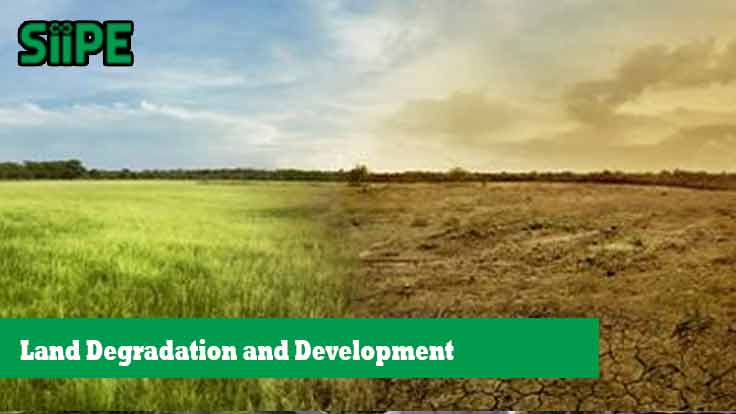Land degradation is a critical issue facing the world today, with profound implications for both the environment and human societies. It refers to the decline in the quality of land, often due to human activities such as deforestation, overgrazing, and improper agricultural practices.
This degradation results in the loss of productive land, reduced biodiversity, and increased vulnerability to climate change. As the global population continues to grow, the demand for land and its resources intensifies, making land degradation a significant challenge that needs to be addressed through sustainable development practices.
Understanding Land Degradation
Land degradation is a complex process that can manifest in various forms, including soil erosion, desertification, salinization, and loss of vegetation cover. Each of these forms has distinct causes and effects, but they all contribute to the overall decline in land productivity.
Soil erosion, for instance, occurs when the topsoil is removed by wind or water, leading to a loss of essential nutrients and reduced agricultural yields. Desertification, on the other hand, refers to the transformation of fertile land into desert-like conditions, often driven by overgrazing, deforestation, and poor land management.
The consequences of land degradation are far-reaching. In addition to the direct impact on agricultural productivity, land degradation can lead to food insecurity, loss of livelihoods, and increased poverty, particularly in developing countries where agriculture is a primary source of income. Moreover, land degradation contributes to climate change by releasing stored carbon into the atmosphere, further exacerbating global warming.
Causes of Land Degradation
The causes of land degradation are multifaceted and often interconnected. One of the primary drivers is unsustainable agricultural practices, such as over-cultivation, monocropping, and excessive use of chemical fertilizers and pesticides.
These practices deplete the soil of its natural nutrients, leading to reduced fertility and increased vulnerability to erosion. Deforestation is another significant contributor to land degradation, as the removal of trees and vegetation disrupts the natural balance of ecosystems, leading to soil erosion and loss of biodiversity.
Overgrazing by livestock is a common issue in many parts of the world, particularly in arid and semi-arid regions. When too many animals graze on the same land, the vegetation cover is diminished, leaving the soil exposed to erosion. Additionally, urbanization and industrial activities contribute to land degradation by converting fertile agricultural land into urban areas, leading to the loss of productive land and the destruction of natural habitats.
Impact on Development
Land degradation poses a significant threat to sustainable development. As the quality of land declines, so does its ability to support agriculture and other forms of productive use. This has a direct impact on food security, particularly in regions where agriculture is the primary source of food and income.
As crop yields decline, food prices rise, making it more difficult for people to access the food they need. In developing countries, where smallholder farmers are often the most affected by land degradation, this can lead to increased poverty and social unrest.
Moreover, land degradation contributes to the loss of biodiversity, as habitats are destroyed and species are forced to migrate or face extinction. This loss of biodiversity has implications for ecosystem services, such as pollination, water purification, and climate regulation, which are essential for human well-being and economic development.
Land degradation also exacerbates the effects of climate change. Degraded land is less able to sequester carbon, leading to higher levels of greenhouse gases in the atmosphere. Additionally, the loss of vegetation cover increases the risk of floods and landslides, particularly in hilly and mountainous regions. As climate change continues to intensify, the impacts of land degradation are likely to become more severe, further undermining efforts to achieve sustainable development goals.
Addressing Land Degradation through Sustainable Development
To combat land degradation and promote sustainable development, a multi-faceted approach is needed. This involves implementing land management practices that are both environmentally sustainable and economically viable.
One such approach is sustainable agriculture, which focuses on maintaining the health of the soil, conserving water, and reducing the use of chemical inputs. Practices such as crop rotation, agroforestry, and organic farming can help restore soil fertility and prevent further degradation.
Reforestation and afforestation are also critical strategies for combating land degradation. By planting trees and restoring vegetation cover, the risk of soil erosion can be reduced, while also providing additional benefits such as carbon sequestration and habitat restoration.
In areas prone to desertification, sustainable land management practices, such as controlled grazing and the use of drought-resistant crops, can help prevent the spread of deserts and maintain productive land.
Another important aspect of addressing land degradation is the protection and restoration of ecosystems. This involves conserving natural habitats, protecting biodiversity, and promoting the sustainable use of natural resources. By ensuring that ecosystems remain healthy and resilient, the negative impacts of land degradation can be mitigated, while also providing benefits such as clean water, air, and food.
The Role of Policy and International Cooperation
Addressing land degradation requires strong political commitment and international cooperation. Governments must implement policies that promote sustainable land management and provide incentives for land users to adopt sustainable practices.
This can include financial support for sustainable agriculture, reforestation projects, and the restoration of degraded land. Additionally, governments must enforce regulations that prevent land degradation, such as restrictions on deforestation and the use of harmful agricultural practices.
International cooperation is also essential, as land degradation is a global issue that transcends national borders. The United Nations Convention to Combat Desertification (UNCCD) is one such initiative that brings together countries to address land degradation and promote sustainable land management.
Through international cooperation, countries can share knowledge, resources, and best practices, and work together to combat the global challenge of land degradation.
significant threats to sustainable development
Land degradation is a significant threat to sustainable development, with far-reaching implications for the environment, food security, and human well-being.
However, by adopting sustainable land management practices, protecting and restoring ecosystems, and promoting international cooperation, the negative impacts of land degradation can be mitigated.
As the global population continues to grow and the demand for land increases, it is essential that we take action to protect and restore our land resources for the benefit of current and future generations.











